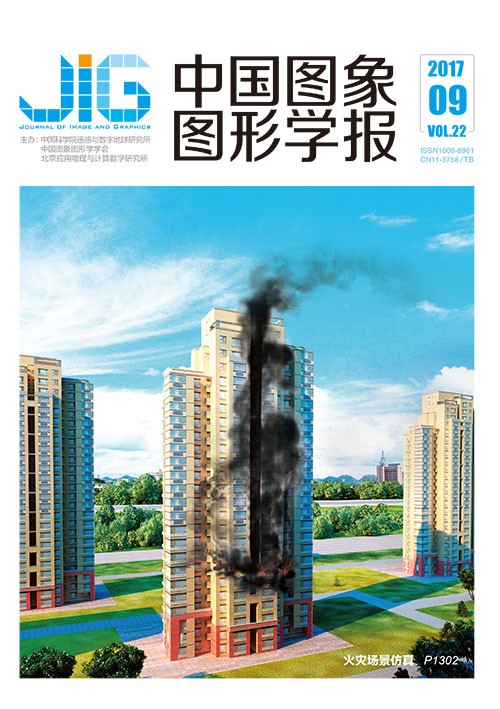
分区域变尺度网格的社区火灾场景数值仿真
摘 要
目的 火灾场景数值仿真对消防救援和应急疏散具有重要意义。火灾场景仿真需要对室内外地物及环境进行精细建模和大量数值计算,而传统地图和空间分析无法满足日趋复杂的建筑物消防场景表达。为此本文基于室内外地图研究基础,构建面向社区安全的火灾场景数值仿真模型。方法 通过传统制图技术建立社区地物分布模型,利用室内制图技术建立建筑物内部场景,利用3维建模技术重建社区室内外3维模型,引入火灾数值模拟方程进行仿真计算。根据社区建筑物分布和其内部结构复杂程度的差异,提出分区域变尺度的网格划分方法,以提高计算效率。结果 通过对红树湾社区进行"精细"、"粗糙"和"分区域变尺度"3种不同方法的仿真实验,分析火灾模型的计算速度、温度场及烟气扩散情况。与精细网格方法相比,分区域变尺度方法和粗糙网格方法的计算速度是其8倍和24倍,烟气最低能见度误差为2 m和13.5 m,分区域变尺度方法相较于粗糙网格方法与精细网格方法的温度变化曲线更加吻合。分区域变尺度方法的模拟精度更接近于精细网格方法,同时效率得到提升。结论 本文提出的火灾场景仿真模型将室内制图应用扩展到社区消防研究,实验结果表明,所提出的分区域变尺度网格划分方法能够在保证数值模拟精度的前提下提高仿真效率,具有重要的应用价值。
关键词
Numerical simulation of a community fire scene based on subregional variable-scale meshing
Zhang Lin1,2, Huang Xiaoxia1, Li Hongga1, Li Xia1(1.Institute of Remote Sensing and Digital Earth, Chinese Academy of Sciences, Beijing 100101, China;2.University of Chinese Academy of Sciences, Beijing 100049, China) Abstract
Objective The community is one of the main places in a city where humans reside.Community security is an important part of the development of a harmonious society.Fire disaster is one of the main factors that threaten community security.A large number of accidents show that toxic fire fumes and a high-temperature environment are the main causes of casualties.A numerical simulation model can analyze smoke flow and temperature distribution that are caused by fire.Therefore,research on community fire scene simulation models is important to fire rescue and emergency evacuation.Fire scene simulation requires models for indoor and outdoor objects and the environment,as well as a large number of numerical calculations.However,a traditional map cannot meet the aforementioned requirements.Method In this study,we propose a fire scene numerical simulation model for community security based on a research on indoor and outdoor maps.The model is required to establish the distribution of community objects through traditional mapping technology.It utilizes indoor mapping technology to create the interior scene of buildings.The contents of the indoor map include the door,fire facility,passage,and room range layers.The contents of the outdoor map include community boundaries,transportation,vegetation,residential buildings,fire facilities,and other layers.A 3D fire scene model is reconstructed using 3D modeling technology.A fire numerical equation is imported to calculate the simulation.The model can be displayed in 3D dynamics.The fire numerical simulation is calculated using the Fire Dynamic Simulation (FDS) software,which was developed by the National Institute of Standards and Technology in the USA.FDS solves the fire numerical simulation equation to calculate the smoke diffusion and heat transfer processes in a single grid as a unit.In theory,a fine grid size provides accurate calculation results.Under the same calculating volume conditions,if a fine grid size is designed,then numerous grids will be generated.A subregional variable-scale meshing method is proposed to improve the efficiency of the fire numerical calculation for the complex structure of a community because computation on numerous grids is costly in terms of time.The following three rules should be followed when setting up a subregional variable-scale meshing.First,a number of calculation regions should be divided according to the shapes of the buildings.The different regions of a grid can overlap,abut,or not be in contact.The details of a fire region should not be divided.Second,the grid size should be set according to the complexity of the community structure and the distance from the fire.The section near the fire scene of the entire indoor and outdoor areas divides the fine grid,and the community near the ground also divides the fine grid.The rough grid is divided at the region that cannot be affected by the fire.Third,the abutting regions should follow the mesh boundary alignment.The most important rule of the mesh boundary alignment is that abutting cells should have the same cross-sectional area or integral ratios.We select the community of Hongshuwan as the study area to conduct the fire numerical simulation experiments.We also use three different meshing methods to experiment on the fire scene simulation in Hongshuwan community,namely,fine meshing,rough meshing,and subregional variable-scale meshing.Result The burning changes of indoor fires can be observed in the results of a single-layer fire simulation model of Hongshuwan community.The fire-burning changes include smoke flow and temperature distribution.We determine that grid size is positively correlated with calculation accuracy by comparing the three meshing methods.Therefore,we set the results of the fine meshing method as the standard to compare the computational accuracy and computational efficiency of the other two meshing methods.For calculation speed,the results of the subregional variable-scale meshing and rough meshing methods are 8 times and 24 times that of the fine meshing method,respectively.The calculation speeds of the subregional variable-scale meshing and rough meshing method are faster than that of the fine meshing method.The temperature simulation results show that the temperature-changing curves of the subregional variable-scale meshing method approximate those of the fine meshing method.The differences between the rough meshing and fine meshing methods are significant.The correlation coefficient of the temperature simulation results between the subregional variable-scale meshing and fine meshing methods is greater than 0.96,which proves that the results of the two methods are highly correlated.Compared with the smoke diffusion results of the fine meshing method,the minimum visibility error of the subregional variable-scale meshing method is 2 m,whereas that of the rough meshing method is 13.5 m.These results show that the smoke simulation accuracy of the subregional variable-scale meshing method is higher than that of the rough meshing method.The simulation accuracy of the subregional variable-scale meshing method is closer to that of the fine meshing method,and its efficiency is higher than that of the fine meshing method.Conclusion In this study,a simulation model for a community fire scene is constructed to extend the application of an indoor map.The smoke diffusion and temperature distribution laws can be analyzed through the aforementioned fire scene numerical simulation model.Subregional variable-scale meshing can improve simulation efficiency while maintaining the level of simulated accuracy.The model can be applied to fire rescue and emergency evacuation at the community scale.The new approach has an important application value.
Keywords
fire scene simulation indoor map sub-regional variable-scale meshing three-dimensional modeling numerical simulation
|



 中国图象图形学报 │ 京ICP备05080539号-4 │ 本系统由
中国图象图形学报 │ 京ICP备05080539号-4 │ 本系统由